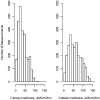Safety and efficacy of filtered sunlight in treatment of jaundice in African neonates
- PMID: 24864170
- PMCID: PMC4531268
- DOI: 10.1542/peds.2013-3500
Safety and efficacy of filtered sunlight in treatment of jaundice in African neonates
Abstract
Objectives: Evaluate safety and efficacy of filtered-sunlight phototherapy (FS-PT).
Methods: Term/late preterm infants #14 days old with clinically significant jaundice, assessed by total bilirubin (TB) levels, were recruited from a maternity hospital in Lagos, Nigeria. Sunlight was filtered with commercial window-tinting films that remove most UV and significant levels of infrared light and transmit effective levels of therapeutic blue light. After placing infants under an FS-PT canopy, hourly measurements of axillary temperatures, monitoring for sunburn, dehydration, and irradiances of filtered sunlight were performed. Treatment was deemed safe and efficacious if infants were able to stay in FS-PT for $5 hours and rate of rise of TB was ,0.2 mg/dL/h for infants #72 hours of age or TB decreased for infants .72 hours of age.
Results: A total of 227 infants received 258 days of FS-PT. No infant developed sunburn or dehydration. On 85 (33%) of 258 treatment days, infants were removed briefly from FS-PT due to minor temperature-related adverse events. No infant met study exit criteria. FS-PT was efficacious in 92% (181/197) of evaluable treatment days. Mean 6 SD TB change was –0.06 6 0.19 mg/dL/h. The mean 6 SD (range) irradiance of FS-PT was 38 6 22 (2–115) mW/cm2/nm, measured by the BiliBlanket Meter II.
Conclusions: With appropriate monitoring, filtered sunlight is a novel, practical, and inexpensive method of PT that potentially offers safe and efficacious treatment strategy for management of neonatal jaundice in tropical countries where conventional PT treatment is not available.
Figures



Similar articles
-
Treatment of neonatal jaundice with filtered sunlight in Nigerian neonates: study protocol of a non-inferiority, randomized controlled trial.Trials. 2013 Dec 28;14:446. doi: 10.1186/1745-6215-14-446. Trials. 2013. PMID: 24373547 Free PMC article. Clinical Trial.
-
Sunlight for the prevention and treatment of hyperbilirubinemia in term and late preterm neonates.Cochrane Database Syst Rev. 2021 Jul 6;7(7):CD013277. doi: 10.1002/14651858.CD013277.pub2. Cochrane Database Syst Rev. 2021. PMID: 34228352 Free PMC article.
-
A Randomized Trial of Phototherapy with Filtered Sunlight in African Neonates.N Engl J Med. 2015 Sep 17;373(12):1115-24. doi: 10.1056/NEJMoa1501074. N Engl J Med. 2015. PMID: 26376136 Clinical Trial.
-
Heliotherapy for Neonatal Hyperbilirubinemia in Southwest, Nigeria: A Baseline Pre-Intervention Study.PLoS One. 2016 Mar 22;11(3):e0151375. doi: 10.1371/journal.pone.0151375. eCollection 2016. PLoS One. 2016. PMID: 27003893 Free PMC article.
-
Filtered sunlight, solar powered phototherapy and other strategies for managing neonatal jaundice in low-resource settings.Early Hum Dev. 2017 Nov;114:11-15. doi: 10.1016/j.earlhumdev.2017.09.008. Epub 2017 Sep 15. Early Hum Dev. 2017. PMID: 28919246 Review.
Cited by
-
Review of bilirubin neurotoxicity II: preventing and treating acute bilirubin encephalopathy and kernicterus spectrum disorders.Pediatr Res. 2020 Jan;87(2):332-337. doi: 10.1038/s41390-019-0603-5. Epub 2019 Oct 3. Pediatr Res. 2020. PMID: 31581172 Review.
-
Maternal satisfaction with a novel filtered-sunlight phototherapy for newborn jaundice in Southwest Nigeria.BMC Pediatr. 2014 Jul 10;14:180. doi: 10.1186/1471-2431-14-180. BMC Pediatr. 2014. PMID: 25012576 Free PMC article.
-
Evaluation of the safety of conventional lighting replacement by artificial daylight.J Microsc Ultrastruct. 2017 Oct-Dec;5(4):206-215. doi: 10.1016/j.jmau.2017.05.005. Epub 2017 Jun 1. J Microsc Ultrastruct. 2017. PMID: 30023256 Free PMC article.
-
Sister Jean Ward, phototherapy, and jaundice: a unique human and photochemical interaction.J Perinatol. 2015 Sep;35(9):671-5. doi: 10.1038/jp.2015.56. Epub 2015 Jun 11. J Perinatol. 2015. PMID: 26067472 No abstract available.
-
A comparison of the effectiveness of three LED phototherapy machines, single- and double-sided, for treating neonatal jaundice in a low resource setting.PLoS One. 2018 Oct 11;13(10):e0205432. doi: 10.1371/journal.pone.0205432. eCollection 2018. PLoS One. 2018. PMID: 30308024 Free PMC article.
References
-
- Young Infants Clinical Signs Study Group . Clinical signs that predict severe illness in children under age 2 months: a multicentre study. Lancet. 2008;371(9607):135–142 - PubMed
-
- Slusher TM, Olusanya BO. Neonatal jaundice in low and middle income countries. In: Stevenson DK, Maisels MJ, JF Watchko, eds. Care of the Jaundiced Neonate. New York, NY: McGraw-Hill; 2012:263–273
-
- Ogunlesi T, Ogundeji M, Ogunfowora O, Olowu A. Socioclinical issues in cerebral palsy in Sagamu, Nigeria. SAJCH. 2008;2:12024
-
- Olusanya BO, Somefun AO. Sensorineural hearing loss in infants with neonatal jaundice in Lagos: a community-based study. Ann Trop Paediatr. 2009;29(2):119–128 - PubMed
Publication types
MeSH terms
Substances
Grants and funding
LinkOut - more resources
Full Text Sources
Other Literature Sources
Medical
Miscellaneous

